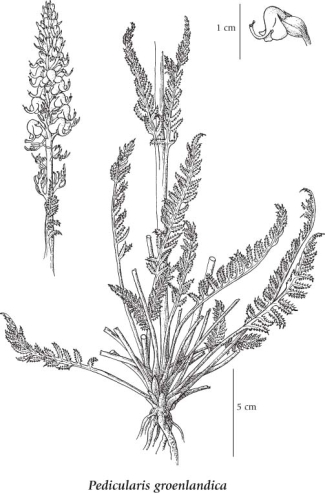Pedicularis groenlandica Retz.
elephant's-head lousewort (elephanthead lousewort)
Orobanchaceae (Broom-rape family)
(Previously in Scrophulariaceae)
Introduction to Vascular Plants
elephant's-head lousewort (elephanthead lousewort)
Orobanchaceae (Broom-rape family)
(Previously in Scrophulariaceae)
Introduction to Vascular Plants
Species Information
General:
Perennial herb from fibrous roots sometimes surmounted by a stem-base, smooth throughout except for the calyx-teeth; stems 1 to several, often clustered, erect, 15-70 cm tall, unbranched, sometimes reddish-purple.
Leaves:
Basal leaves long-stalked, oblong-lanceolate, 5-25 cm long, pinnately lobed to deeply cleft, the lobes narrow and toothed; stem leaves alternate, several, reduced and becoming unstalked upward.
Flowers:
Inflorescence a fairly dense, elongated, bracted, terminal spike of numerous flowers, the spike smooth, 4-20 cm long, the bracts similar to the leaves but much reduced, shorter than the flowers; corollas pink to reddish-purple, 10-25 mm long including the beak, 2-lipped, the upper lip short (2-3 mm), strongly hooded, prolonged into an elongate, upcurved beak (resembling an elephant trunk) 7-18 mm long, the lower lip 3-8 mm long, 3-lobed, the lobes deflexed-spreading; calyces 4-7 mm long, 5-toothed, the teeth broadly triangular, more or less equal, about 1 mm long, fringed with hairs; stamens 4, the filaments smooth.
Fruits:
Capsules, asymmetrical, 7-14 mm long; seeds several, about 3 mm long, winged, net-veined.
Illustration

If more than one illustration is available for a species (e.g., separate illustrations were provided for two subspecies) then links to the separate images will be provided below. Note that individual subspecies or varietal illustrations are not always available.
Illustration Source: The Illustrated Flora of British Columbia
USDA Species Characteristics
Flower Colour:
Purple
Blooming Period:
Late Spring
Fruit/Seed characteristics:
Colour: Brown
Present from Spring to Summer
Source: The USDA
Ecology
Ecological Framework for Pedicularis groenlandica
The table below shows the species-specific information calculated from
original data (BEC database) provided by the BC Ministry of Forests and Range.
(Updated August, 2013)
The table below shows the species-specific information calculated from
original data (BEC database) provided by the BC Ministry of Forests and Range.
(Updated August, 2013)
| Site Information |
Value / Class |
||
|
Avg |
Min |
Max |
|
| Elevation
(metres) |
1540 | 6 | 2322 |
| Slope
Gradient (%) |
9 | 0 | 80 |
|
Aspect (degrees) |
286 | 10 | 360 |
| Soil
Moisture Regime (SMR) [0 - very xeric; 4 - mesic; 8 - hydric] |
5 | 1 | 8 |
| Modal
Nutrient Regime
Class |
C | ||
| #
of field plots species was recorded in: |
86 | ||
| Modal
BEC Zone Class |
ESSF | ||
|
All BEC Zones (# of stations/zone) species was recorded in |
AT(3), BAFA(3), BWBS(7), CMA(2), ESSF(44), IDF(1), MH(1), MS(3), SBS(4), SWB(2) | ||
|
Source:
Klinkenberg 2013
|
|||
Habitat and Range
Moist to wet meadows, thickets, swamps, seepage sites and streambanks in the montane to subalpine zones; locally frequent in and E of the Coast-Cascade Mountains in S BC, infrequent northward E of the Coast Mountains; N to S AK, YT and NT; E to PQ and S to NM, AZ and CA; Greenland.Status Information
Synonyms
Synonyms and Alternate Names:
Elephantella groenlandica (Retz.) Rydb.
Pedicularis groenlandica subsp. surrecta (Benth.) Piper
Pedicularis groenlandica var. surrecta (Benth.) A. Gray